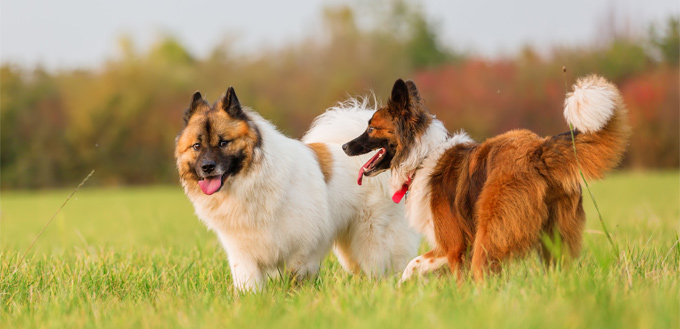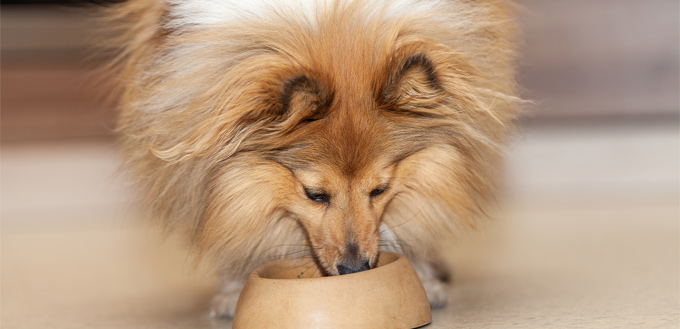Giving our dogs a well-balanced diet is one of the key ways we can help them lead a longer, healthier life. A diet full of processed food that’s high in fat, sugar, and salt is as bad for our canine friends as it is for us as humans. But what is good for a dog to eat specifically and why?
Within the food we give them, we should include antioxidants just like we try to include in our own diets. What makes antioxidants even more beneficial when included in dog food, is the fact that antioxidants help preserve it so it lasts a long time. This can sometimes be both a blessing and a curse, which we will investigate further with respect to the implications of preservatives on dogs’ health.
We also discover and investigate why antioxidants can be so helpful to a dog’s health and why we should ensure we give them to our canines at any given opportunity. We learn that it is very easy to do and that we are missing a trick if we don’t even try to supplement our four-legged best friend’s diet with antioxidants that are so easily available.

What Do Antioxidants In Dog Food Do?
The health benefits of antioxidants are pretty far-reaching. While they certainly do help to preserve the food they can do far more than that too.
Primarily, antioxidants help a dog’s body fight off infection by improving their immune system as well as working to strengthen the cells in a dog’s body and protecting those cells from any damage. Damage can occur on a daily basis from something called free radicals. Free radicals occur in the body due to the process of oxidation that damages body cells. These very free radicals then go on to cause further damage to our cells heightening the problem of oxidation. They are an unstable entity that the body has little defense against, other than through the help of antioxidants.
Antioxidants, therefore, are imperative to have in a dog’s diet. They work towards defending the body against further cell damage as well as impeding the progress that free radicals can make. Further still, they enhance and strengthen the immune system which can be plagued by free radicals so much so that the body’s ability to fight off infections and illnesses is diminished. Obviously, the knock-on effect of this is that if the body is able to remain healthy and strong against smaller infections, it has far deeper resources to fight off more serious illnesses in the future too.
Antioxidants are therefore key to use. One of the most essential times to employ their use is when young dogs and puppies are yet to be vaccinated against serious diseases. At this point, puppies can be in danger of contracting many infections before they have had their vital jabs. Antioxidants give them added protection that can help them stay healthy before their vaccinations do their work instead.
For older dogs, the chances of oxidation damage occurring to their internal organs are heightened and so an antioxidant-rich diet is still key. This is because antioxidants help in the fight against oxidative damage and so an older dog has a much-improved chance of leading a long and healthy life. For a wider selection of choices, check out our senior dog foods and supplements for older dogs guides.
How Do Antioxidants Work?
This Is all very well, but how exactly do antioxidants in dog food really work? Why do antioxidants help protect our dogs against oxidative damage? It’s key to know this so that we are, as owners, then able to go on to buy suitable dog food or supplements as required. Without knowing the science behind the thought process that dogs need an antioxidant-rich diet, we may be duped into buying dog food that is not suitable for the purpose. Or worse, trying to cobble together a special diet program for them on our own that does not provide your beloved pet with the ballast or nutrients that he or she needs.
So what are the free radicals that antioxidants protect against and how do free radicals cause our bodies harm?
Free radicals, that we have mentioned, are unfortunately natural produced by the body during the breakdown of food and the general every day running of a dog’s body – the same occurs within humans. However, when dogs and even humans, are run down free radicals are produced in greater amounts, especially if your dog is older or has suffered from a nutritionally lacking diet for a lot of his or her life.
Free radicals are cells that carry oxygen and also that are missing an electron. It is this imbalance in its charge that makes them dangerous to the dog’s body. To make up the balance in charge, they attack the body’s other cells in search of another electron, which they find in cell membranes or other DNA or protein. This attack on a healthy cell means that that healthy cell goes on to become a free radical. This means the process of cell damage can go on and on as the body is otherwise powerless to stop it. It is because of this that free radicals and their unstable natures are so bad for our dogs’ bodies.
You May Also Like: High Protein Dog Food

So where do antioxidants fit into this story? Well, antioxidants are perfect for stopping the damage that free radicals can wreak on our bodies. This is because antioxidants are able to give an electron to a free radical without the need for one to be found from a healthy cell. The self-perpetuating cycle of cell damage and free radical creation is therefore stopped and so the body can begin to balance itself again. It Is for this reason that, by providing our dogs with antioxidant-rich foods, we are actively supporting their immune system and strengthening their ability to stay fit and healthy. Through the use of antioxidants, the fight against free radicals becomes much easier for dogs.
The process of addressing cell damage through charge imbalance is even more important when you consider that it has been seen to hinder the even helps with the deterioration of a dog’s brain. Studies have shown that dogs who have had a life where they were provided an antioxidant-rich diet meant that they had a much better ability to learn difficult commands and tasks set for them by their master. The oxidation damage that is caused to cells in dogs’ has been seen therefore in their’ brains as well as other organs. The study into the dog’s cognitive ability, therefore, helped to prove that antioxidants were able to diminish the damage caused by oxidation and free radicals.
Furthermore, studies have shown that dogs who had their food enriched with antioxidants saw a great deal less deterioration in their brain function. Dogs over the age of 7 often display signs of their age by licking themselves excessively as well as repeating their steps over and over again. However, dogs over 7 who had been given a diet of food that had been enriched with antioxidants were still quite mobile as well as still having the ability to recognize their owners and other family members.
Finally, dogs who had suffered from skin problems, allergies, and issues with their fur, who were then fed an antioxidant-rich diet were often seen to have an improvement in these conditions. Other studies further demonstrated and confirmed the fact that puppies who were given antioxidants in their diet before they had their jabs had their immune system vastly improved.
Related Post: Dog Food for Allergies
Where Do Antioxidants in Dog Food Come From?
So now we know why antioxidants are so important in dog food and how they work, how do we ensure they get them from this point forward? Where can we find them and how can we give them to our dogs to ingest in the most efficient manner?
Antioxidants can occur naturally in food but they can also be man-made. Natural antioxidants are substances that most of us will have heard of already. They include vitamin E, vitamin C, rosemary, and its oil, as well as citric acid. Vitamin C is easily found in fruits that are common to many household fruit bowls like apples, tomatoes, or blueberries. Cranberries are also a great source of Vitamin C and a whole host of vegetables are too. To find Vitamin E, look no further than a great deal of dog food or popular kibble. Within the ingredients you won’t see it written as Vitamin E, rather you will see it written as mixed tocopherols so look for that on the label if you are concerned. Finally, citric acid can be found in most citrus fruits. The best sources are lemons, limes, or oranges. These are obviously more difficult to give to dogs who may be put off by their sour taste.
Back in the ingredients list of dog food is where you will find the man-made antioxidants that your dog’s kibble includes. To make sure that it does, in fact, include antioxidants, look out for terms like BHA and BHT, or even ethoxyquin. BHT, in particular, is a popular and common synthetic antioxidant as it mixes well with naturally found Vitamin E – both of which are stable even at high temperatures.
It is ethoxyquin that often makes the headlines, however. It is used commonly in dog food as it is fantastic for preserving and lengthening the life of kibble. However, the FDA now only allow small quantities of the synthetic antioxidant to be included owing to a few concerns about the side effects when too much is ingested.
You May Also Like: Dry Dog Food

What Food Should I Buy My Dog?
Going down the dog food aisle in the supermarket or pet store can be quite an intimidating process. There is simply so much choice these days as to what to give your dog in terms of breed, size, and age.
However, if you are looking for dog food that contains antioxidants, remember that by law, food companies have to list antioxidants by their chemical name but also their layman terminology. There will also be an added notation where an antioxidant has been used as a preservative to extend the shelf life of the kibble or food itself.
You May Also Like: Large Breed Dog Food and Dog Food for Small Breeds
We may look to food that includes only naturally occurring antioxidants in reaction to some negative headlines around the use of synthetic ones and their role in food preservation. However, logistically speaking, naturally occurring antioxidants have a very short shelf life so are not always practical to use. Plus it is a controversial topic to claim that natural antioxidants are more powerful and healthier than synthetic ones. Scientifically speaking, there are arguments for both sides of that story. Most vets seem happiest with using kibble that has a mixture of both naturally occurring antioxidants and synthetic ones too. This mixture seems capable of providing dogs with the protection of their immune system that we seek.
The key rule is to check when the best before date is. If it is close to the current date, and it is a huge bag of the stuff, don’t cut corners by buying it and giving it to your dog all the name of saving a few bucks. It is simply not good for them, but we all know our dogs would eat it anyway.
Once you have purchased your dog’s food of choice, take care in where you’ll finally store it by making sure you keep it in a cool dry place as well as in a Tupperware that seals out all air. This will help extend the life of the antioxidants included in the food as light and air tend to kill them off as well as making the food itself lose its freshness. For this reason, some owners buy smaller bags to maintain longevity and optimal use for their pets.
Related Post: Nature’s Variety Dog Food Reviews






